CHEVROLET CAMARO 1995 4.G Owners Manual
Manufacturer: CHEVROLET, Model Year: 1995, Model line: CAMARO, Model: CHEVROLET CAMARO 1995 4.GPages: 388, PDF Size: 19.69 MB
Page 351 of 388
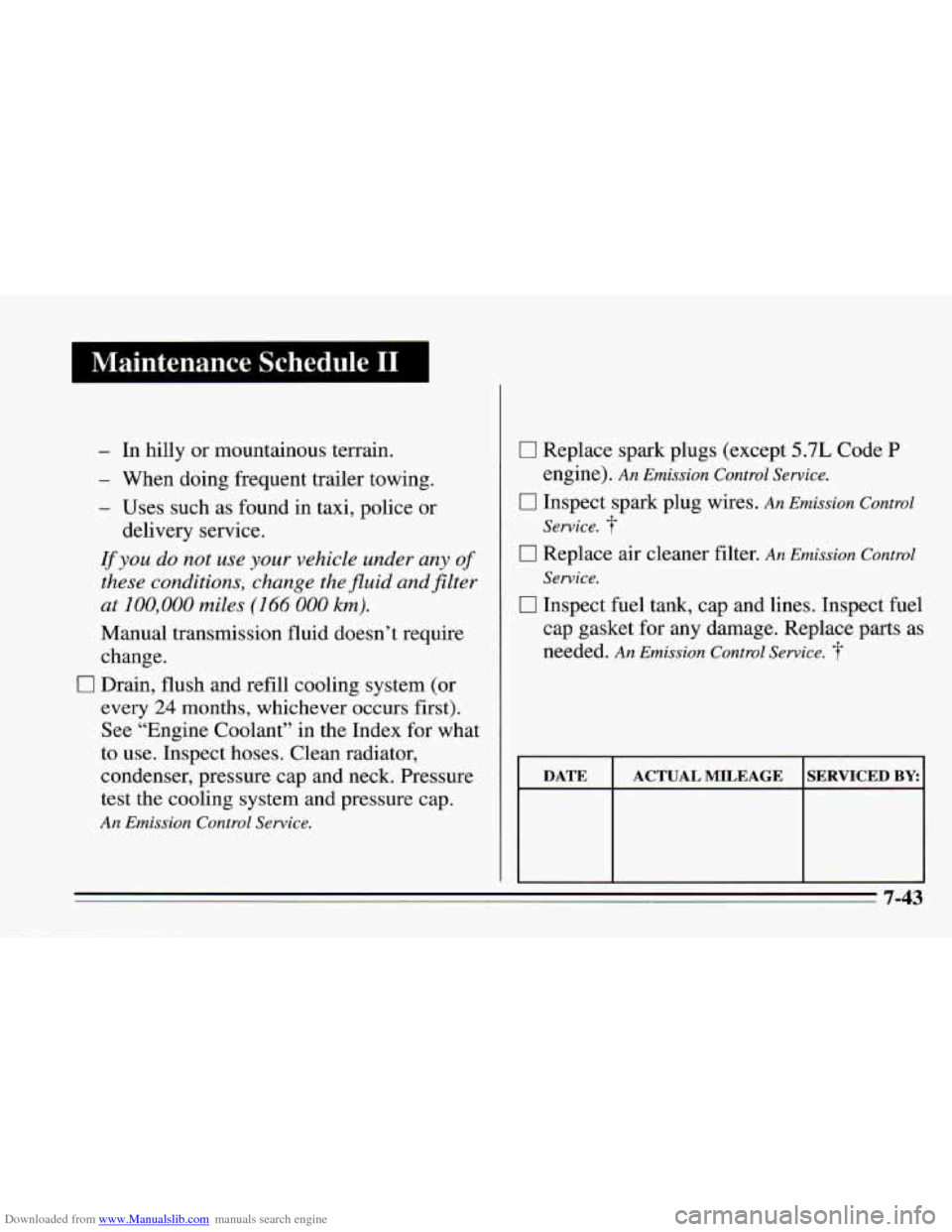
Downloaded from www.Manualslib.com manuals search engine I Maintenance Schedule I1 I
- In hilly or mountainous terrain.
- When doing frequent trailer towing.
- Uses such as found in taxi, police or
vyou do not use your vehicle under any of
these conditions, change the fluid and filter
at
100,000 miles (I 66 000 km).
Manual transmission fluid doesn’t require
change.
0 Drain, flush and refill cooling system (or
every
24 months, whichever occurs first).
See “Engine Coolant’’ in the Index for what
to use. Inspect hoses. Clean radiator,
condenser, pressure cap and neck. Pressure
test the cooling system and pressure cap.
delivery service.
An Emission Control Service.
0 Replace
spark plugs (except 5.7L Code P
0 Inspect spark plug wires. An Emission Control
0 Replace air cleaner filter. An Emission Control
0 Inspect fuel tank, cap and lines. Inspect fuel
cap gasket for any damage. Replace parts as
needed.
An Emission Control Service. T
engine). An Emission Control Service.
Service.
Service.
I DATE ACTUAL MILEAGE SERVICED BY:
7-43
Page 352 of 388
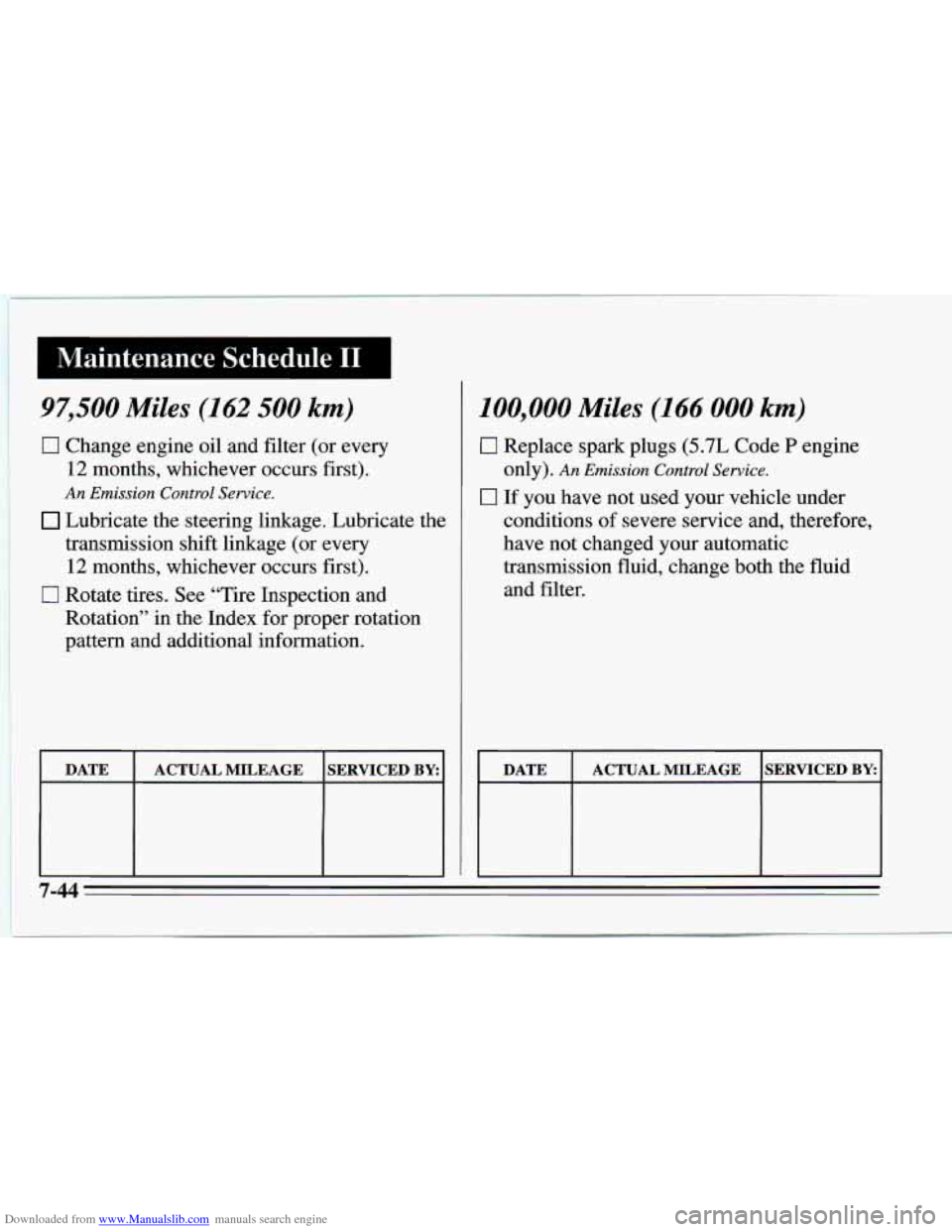
Downloaded from www.Manualslib.com manuals search engine Maintenance Schedule I1 I
97,500 Miles (162 500 km)
0 Change engine oil and filter (or every
12 months, whichever occurs first).
An Emission Control Service.
Lubricate the steering linkage. Lubricate the
transmission shift linkage (or every
12 months, whichever occurs first).
0 Rotate tires. See “Tire Inspection and
Rotation” in the Index for proper rotation
pattern and additional information.
DATE SERVICED BY: ACTUAL MILEAGE
100,000 Miles (166 000 km)
0 Replace spark plugs (5.7L Code P engine
0 If you have not used your vehicle under
only).
An Emission Control Service.
conditions
of severe service and, therefore,
have not changed your automatic
transmission fluid, change both the fluid
and filter.
DATE SERVICED BY: ACTUAL MILEAGE
7-44
Page 353 of 388
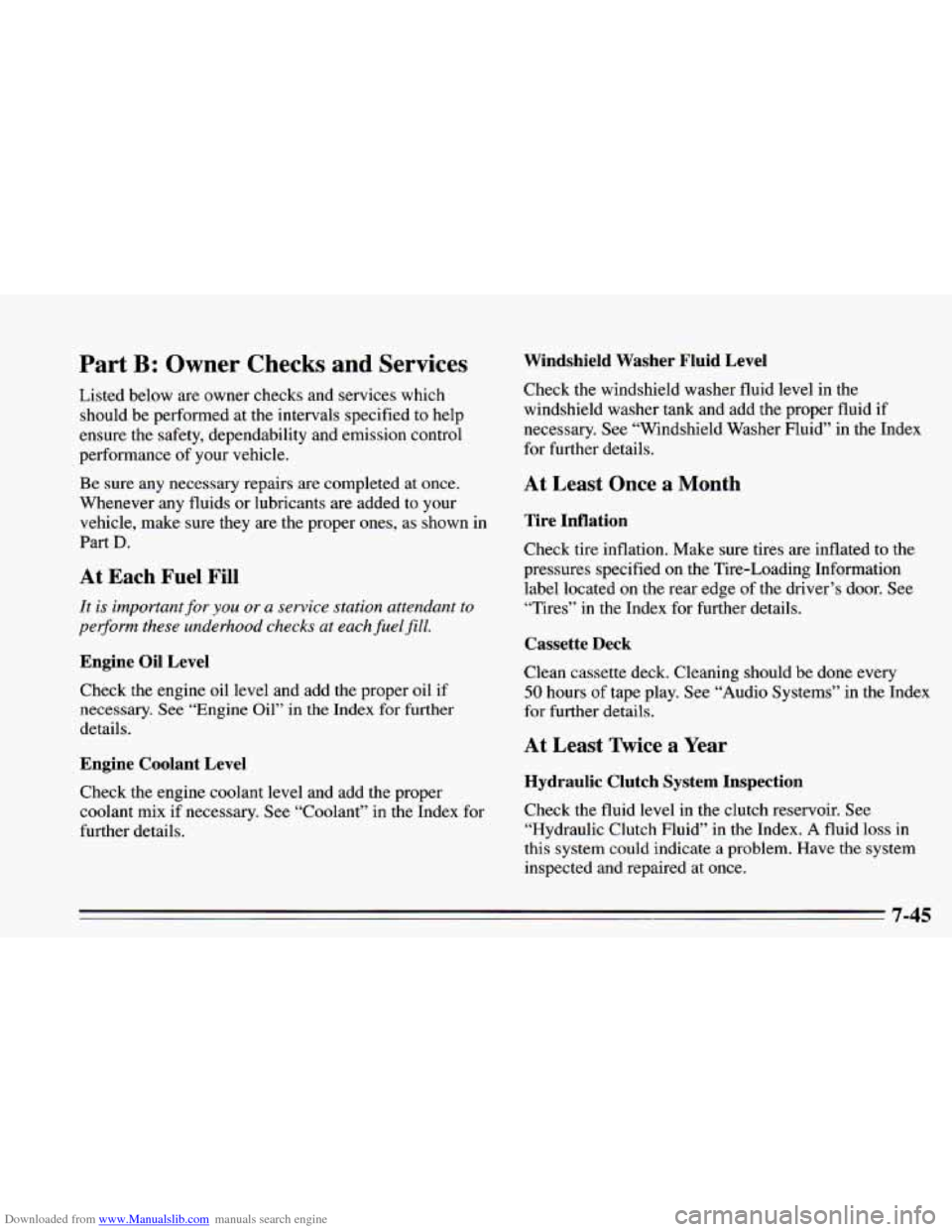
Downloaded from www.Manualslib.com manuals search engine Part B: Owner Checks and Services
Listed below are owner checks and services which
should be performed at the intervals specified to help
ensure the safety, dependability and emission control
performance
of your vehicle.
Be sure any necessary repairs are completed at once.
Whenever any fluids or lubricants are added to your
vehicle, make sure they are the proper ones, as shown in
Part
D.
At Each Fuel Fill
It is important for you or a service station attendant to
pevorm these underhood checks at eachfielfill.
Engine Oil Level
Check the engine oil level and add the proper oil if
necessary. See “Engine Oil” in
the Index for further
details.
Engine Coolant Level
Check the engine coolant level and add the proper
coolant mix if necessary. See “Coolant”
in the Index for
further details.
Windshield Washer Fluid Level
Check the windshield washer fluid level in the
windshield washer tank and add the proper fluid if
necessary. See “Windshield Washer Fluid” in the Index
for further details.
At Least Once a Month
Tire Inflation
Check tire inflation. Make sure tires are inflated to the
pressures specified
on the Tire-Loading Information
label located on the rear edge
of the driver’s door. See
“Tires”
in the Index for further details.
Cassette Deck
Clean cassette deck. Cleaning should be done every
50 hours of tape play. See “Audio Systems” in the Index
for further details.
At Least Twice a Year
Hydraulic Clutch System Inspection
Check the fluid level in the clutch reservoir. See
“Hydraulic Clutch Fluid”
in the Index. A fluid loss in
this system could indicate a problem. Have the system
inspected and repaired at once.
7-45
Page 354 of 388
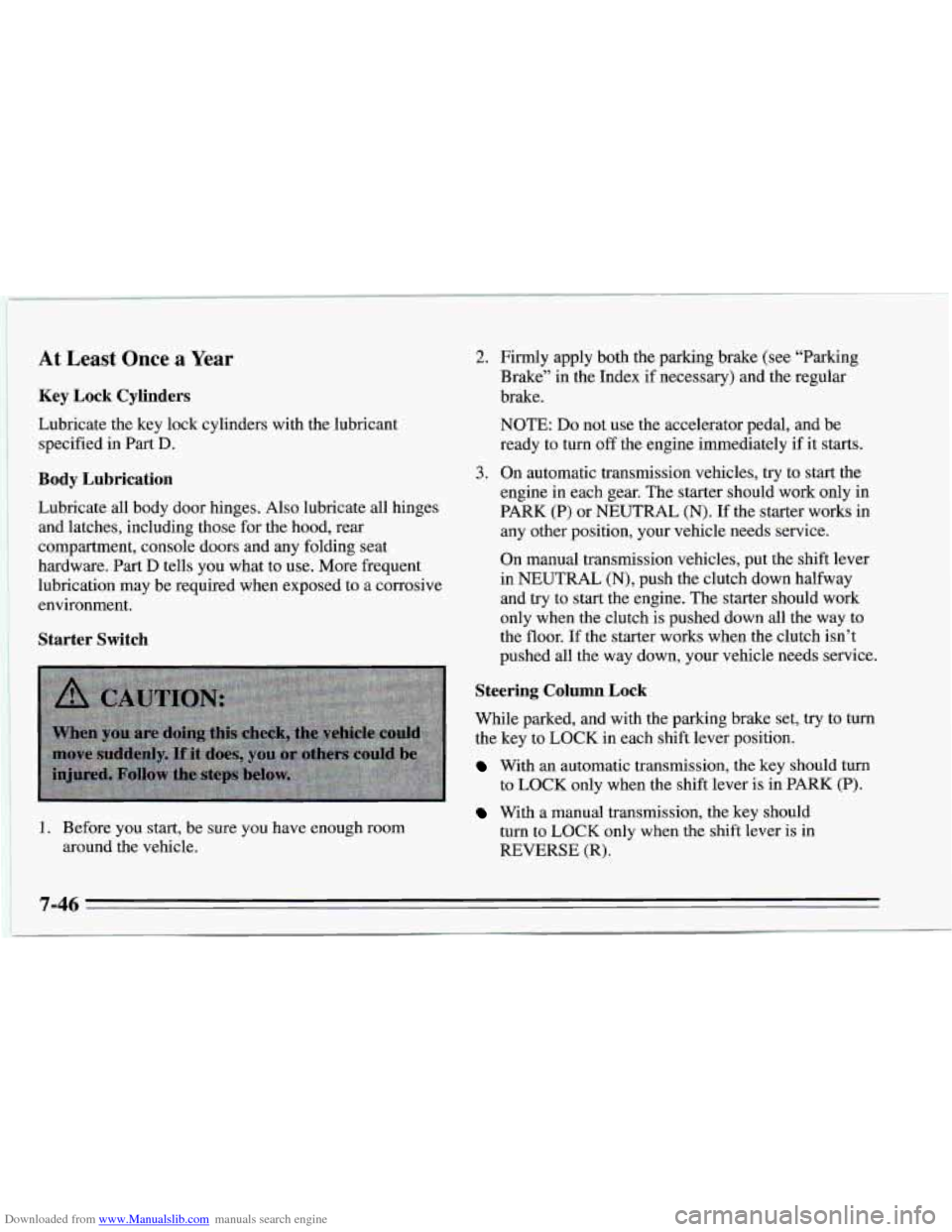
Downloaded from www.Manualslib.com manuals search engine At Least Once a Year
Key Lock Cylinders
Lubricate the key lock cylinders with the lubricant
specified in Part
D.
Body Lubrication
Lubricate all body door hinges. Also lubricate all hinges
and latches, including those for the hood, rear
compartment, console doors and any folding seat
hardware.
Part D tells you what to use. More frequent
lubrication may be required when exposed to a corrosive
environment.
Starter Switch
1. Before you start, be sure you have enough room
around the vehicle.
2. Firmly apply both the parking brake (see ‘Tarking
Brake” in the Index if necessary) and the regular
brake.
NOTE:
Do not use the accelerator pedal, and be
ready to turn
off the engine immediately if it starts.
3. On automatic transmission vehicles, try to start the
engine in each gear. The starter should work only in
PARK
(P) or NEUTRAL (N). If the starter works in
any other position, your vehicle needs service.
On manual transmission vehicles, put the shift lever
in NEUTRAL (N), push the clutch down halfway
and
try to start the engine. The starter should work
only when
the clutch is pushed down all the way to
the floor. If the starter works when the clutch isn’t
pushed all the way down, your vehicle needs service.
Steering Column Lock
While parked, and with the parking brake set, try to turn
the key to LOCK in each shift lever position.
With an automatic transmission, the key should turn
to LOCK only when the shift lever is in PARK
(P).
With a manual transmission, the key should
turn to LOCK only when
the shift lever is in
REVERSE (R).
Page 355 of 388
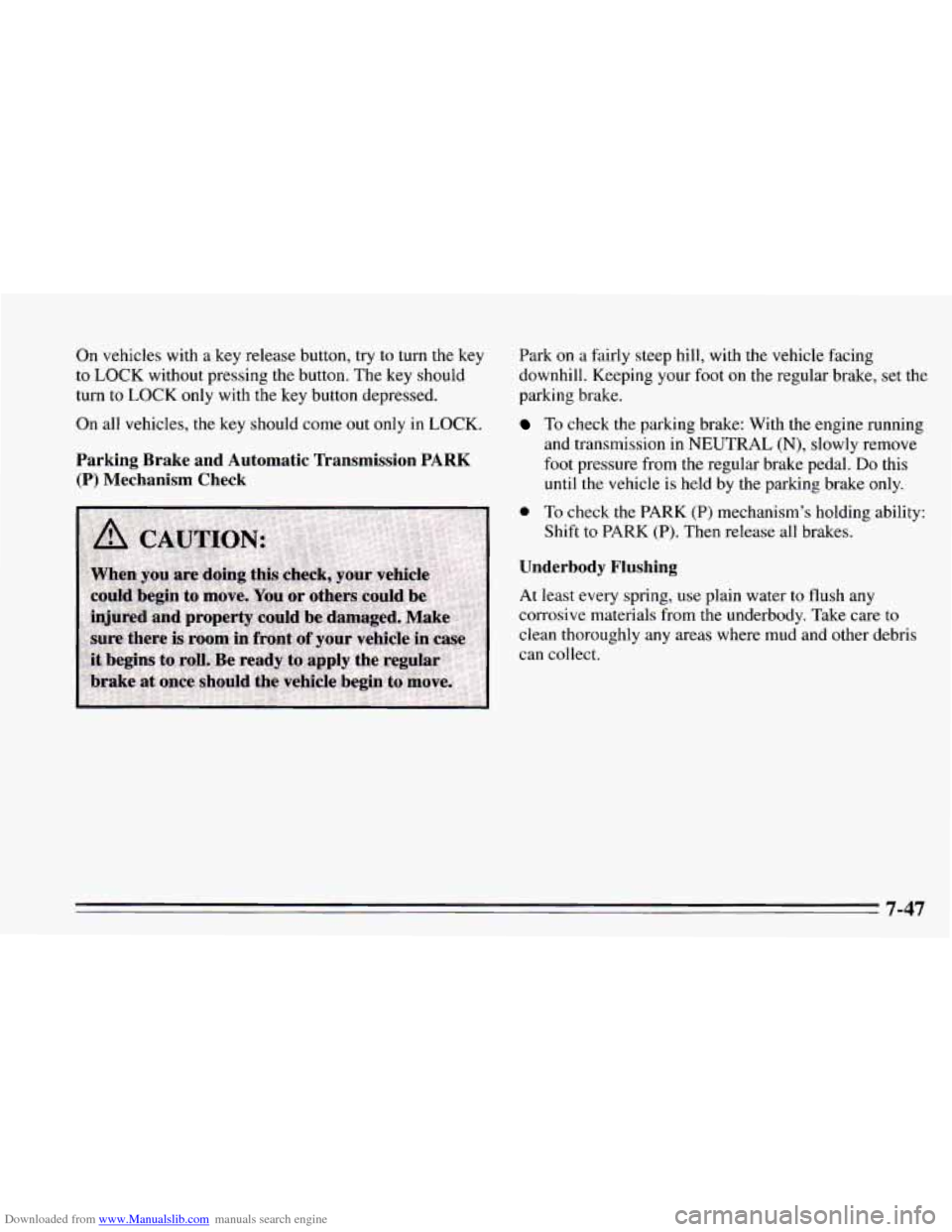
Downloaded from www.Manualslib.com manuals search engine On vehicles with a key release button, try to turn the key
to LOCK without pressing the button. The key should
turn
to LOCK only with the key button depressed.
On all vehicles. the key should come out only in LOCK.
Parking Brake and Automatic Transmission PARK
(P) Mechanism Check
Park on a fairly steep hill, with the vehicle facing
downhill. Keeping your foot
on the regular brake, set the
parking brake.
To check the parking brake: With the engine running
and transmission in NEUTRAL
(N), slowly remove
foot pressure from the regular brake pedal. Do this
until the vehicle is held by the parking brake only.
0 To check the PARK (P) mechanism’s holding ability:
Shift to PARK
(P). Then release all brakes.
Underbody Flushing
At least every spring, use plain water to flush any
corrosive materials from the underbody. Take care
to
clean thoroughly any areas where mud and other debris
can collect.
7-47
Page 356 of 388
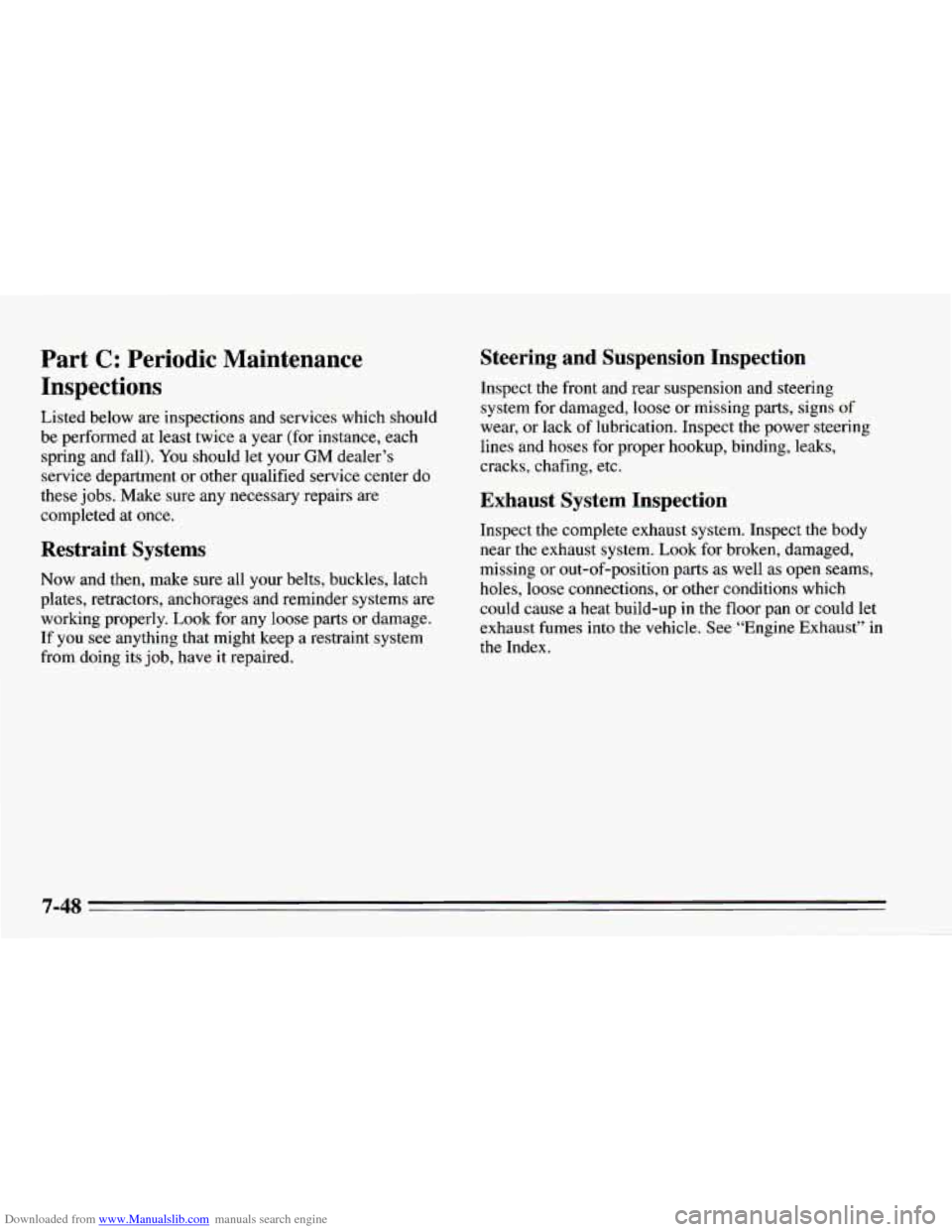
Downloaded from www.Manualslib.com manuals search engine Part C: Periodic Maintenance
Inspections
Listed below are inspections and services which should
be performed at least twice a year (for instance, each
spring and fall). You should let your
GM dealer’s
service department or other qualified service center do
these jobs. Make sure any necessary repairs are
completed at once.
Restraint Systems
Now and then, make sure all your belts, buckles, latch
plates, retractors, anchorages and reminder systems are
working properly.
Look for any loose parts or damage.
If you see anything that might keep a restraint system
from doing its job, have it repaired.
Steering and Suspension Inspection
Inspect the front and rear suspension and steering
system for damaged, loose or missing parts, signs
of
wear, or lack of lubrication. Inspect the power steering
lines and hoses for proper hookup, binding, leaks,
cracks, chafing, etc.
Exhaust System Inspection
Inspect the complete exhaust system. Inspect the body
near the exhaust system. Look for broken, damaged,
missing or out-of-position parts as well as open seams,
holes, loose connections, or other conditions which
could cause a
heat build-up in the floor pan or could let
exhaust fumes into the vehicle. See “Engine Exhaust” in
the Index.
7-48
Page 357 of 388
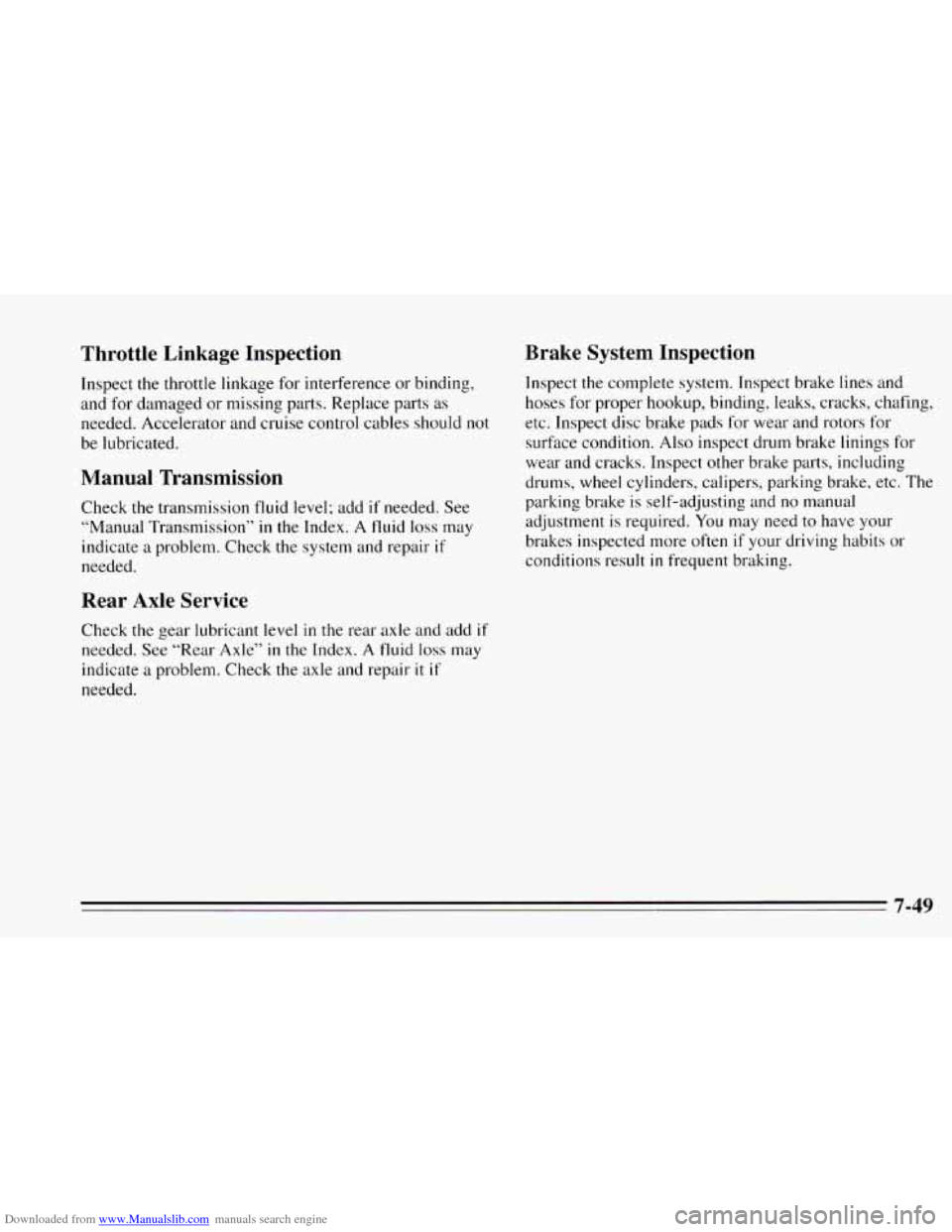
Downloaded from www.Manualslib.com manuals search engine Throttle Linkage Inspection
Inspect the throttle linkage for interference or binding,
and for damaged or missing parts. Replace parts as
needed. Accelerator and cruise control cables should
not
be lubricated.
Manual Transmission
Check the transmission fluid level; add if needed. See
“Manual Transmission”
in the Index. A fluid loss may
indicate a problem. Check the system and repair
if
needed.
Rear Axle Service
Check the gear lubricant level in the rear axle and add if
needed. See “Rear Axle” in the Index. A fluid loss may
indicate a problem. Check the axle and repair
it if
needed.
Brake System Inspection
Inspect the complete system. Inspect brake lines and
hoses for proper hookup, binding, leaks, cracks, chafing,
etc. Inspect disc brake pads for wear and rotors for
surface condition. Also inspect drum brake linings for
wear and cracks. Inspect other brake parts, including
drums, wheel cylinders, calipers, parking brake, etc. The
parking brake
is self-adjusting and no manual
adjustment
is required. You may need to have your
brakes inspected more often
if your driving habits or
conditions result in frequent braking.
7-49
Page 358 of 388
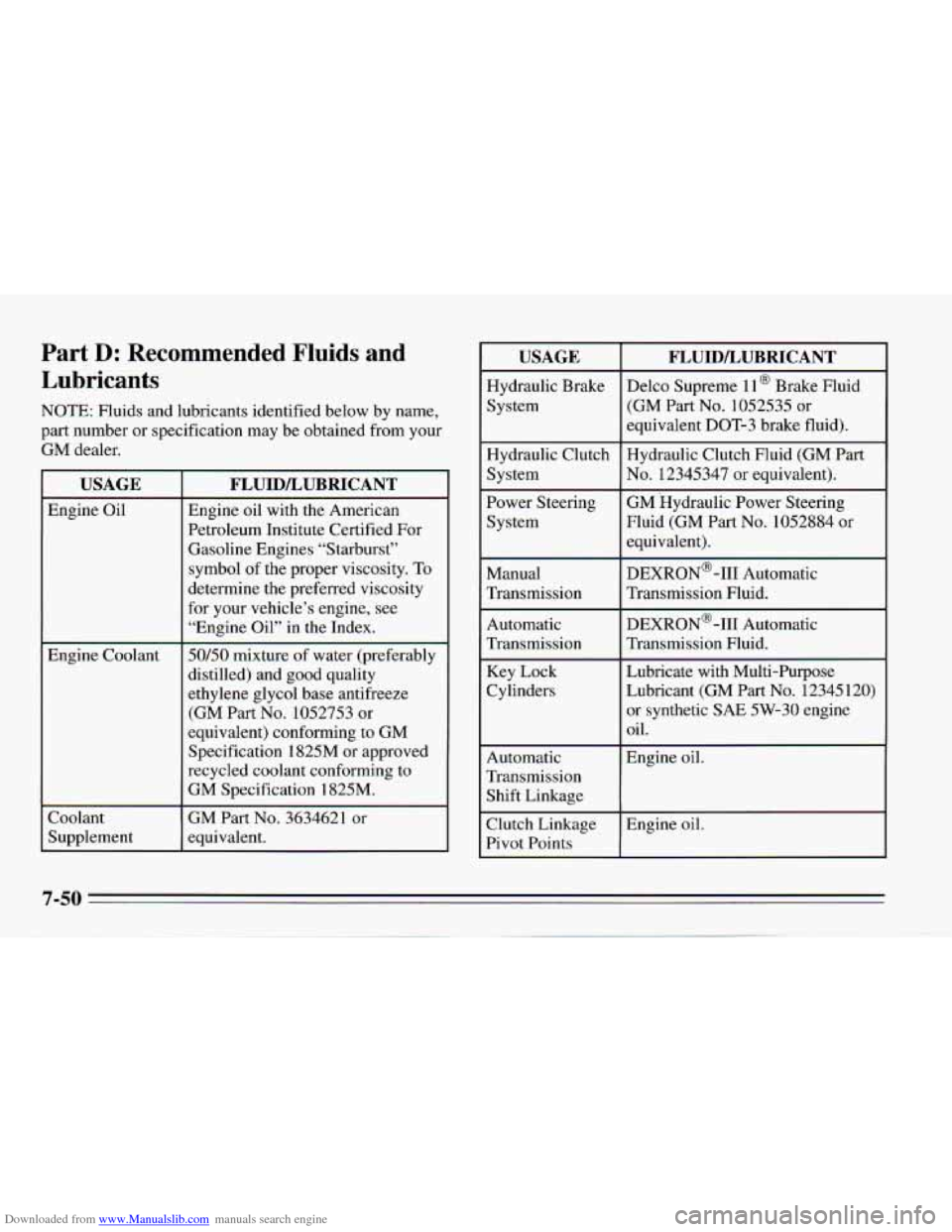
Downloaded from www.Manualslib.com manuals search engine Part D: Recommended Fluids and
Lubricants
NOTE: Fluids and lubricants identified below by name,
part number or specification may be obtained from your
GM dealer.
I USAGE
Supplement
FLUIDLUBRICANT
Engine oil with the American
Petroleum Institute Certified For
Gasoline Engines “Starburst”
symbol
of the proper viscosity. To
determine the preferred viscosity
for your vehicle’s engine, see
“Engine Oil” in the Index.
50/50 mixture of water (preferably
distilled) and good quality
ethylene glycol base antifreeze
(GM Part No. 1052753 or
equivalent) conforming to GM
Specification 1825M or approved
recycled coolant conforming to
GM Specification 1825M.
GM Part No. 3634621 or
equivalent.
USAGE FLUIDLUBRICANT
Hydraulic Brake Delco Supreme 11 @ Brake Fluid
System (GM Part
No. 1052535 or
equivalent DOT-3 brake fluid).
Hydraulic Clutch Hydraulic Clutch Fluid
(GM Part
System No. 12345347
or equivalent).
Power Steering
GM Hydraulic Power Steering
System Fluid (GM Part
No. 1052884 or
equivalent).
Manual DEXRON@-I11 Automatic
Transmission Transmission Fluid.
Automatic DEXRON@-IIT Automatic
Transmission Transmission Fluid.
Key Lock Lubricate with Multi-Purpose
Cylinders Lubricant (GM Part
No. 12345120)
or synthetic
SAE 5W-30 engine
oil.
Automatic Engine oil.
Transmission
Shift Linkage
Clutch Linkage Engine oil.
Pivot Points
Page 359 of 388
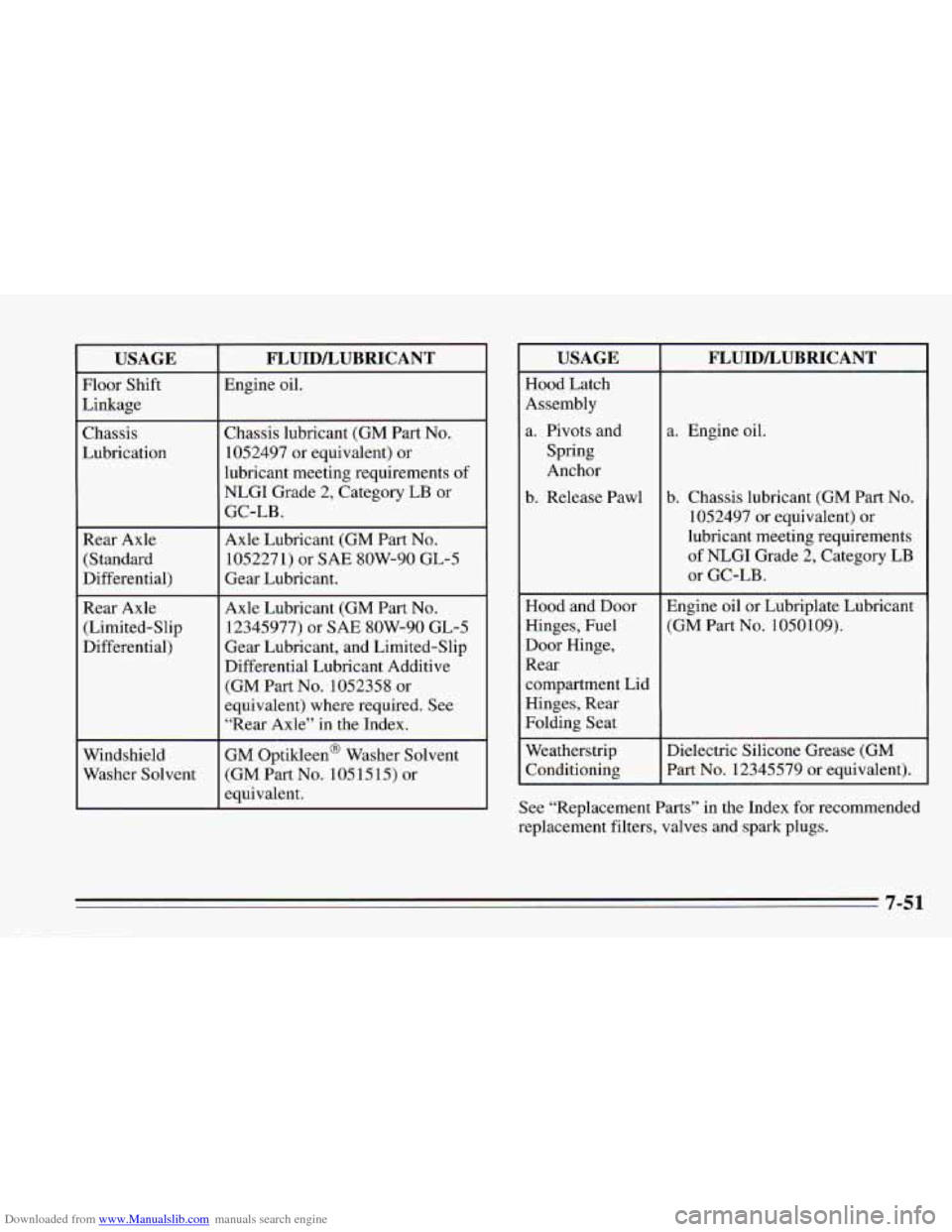
Downloaded from www.Manualslib.com manuals search engine USAGE
Floor Shift
Linkage
Chassis
Lubrication
Rear Axle (Standard
Differential)
Rear Axle (Limited-Slip
Differential)
Windshield Washer Solvent
FLUID/LUBRICANT
Engine oil.
Chassis lubricant (GM Part
No.
1052497 or equivalent) or
lubricant meeting requirements of
NLGI Grade 2, Category LB or
Axle Lubricant (GM Part
No.
1052271) or SAE SOW-90 GL-5
Gear Lubricant.
Axle Lubricant (GM Part
No.
12345977) or SAE 8OW-90 GL-5
Gear Lubricant, and Limited-Slip
Differential Lubricant Additive (GM Part
No. 1052358 or
equivalent) where required. See
“Rear Axle” in the Index.
GM Optikleen@ Washer Solvent
(GM Part
No. 1051515) or
equivalent.
GC-LB.
USAGE
Hood
Latch
Assembly
a. Pivots and Spring
Anchor
b. Release Pawl
Hood and
Door
Hinges, Fuel
Door Hinge,
Rear
compartment Lid
Hinges, Rear
Folding Seat
Weatherstrip Conditioning
FLUIDLUBRICANT
a. Engine oil.
b. Chassis lubricant (GM Part No.
1052497 or equivalent) or
lubricant meeting requirements
of NLGI Grade 2, Category LB
or GC-LB.
Engine oil or Lubriplate Lubricant
(GM Part
No. 1050109).
Dielectric Silicone Grease (GM
Part
No. 12345579 or equivalent).
See “Replacement Parts” in the Index for recommended
replacement filters, valves and
spark plugs.
7-51
Page 360 of 388
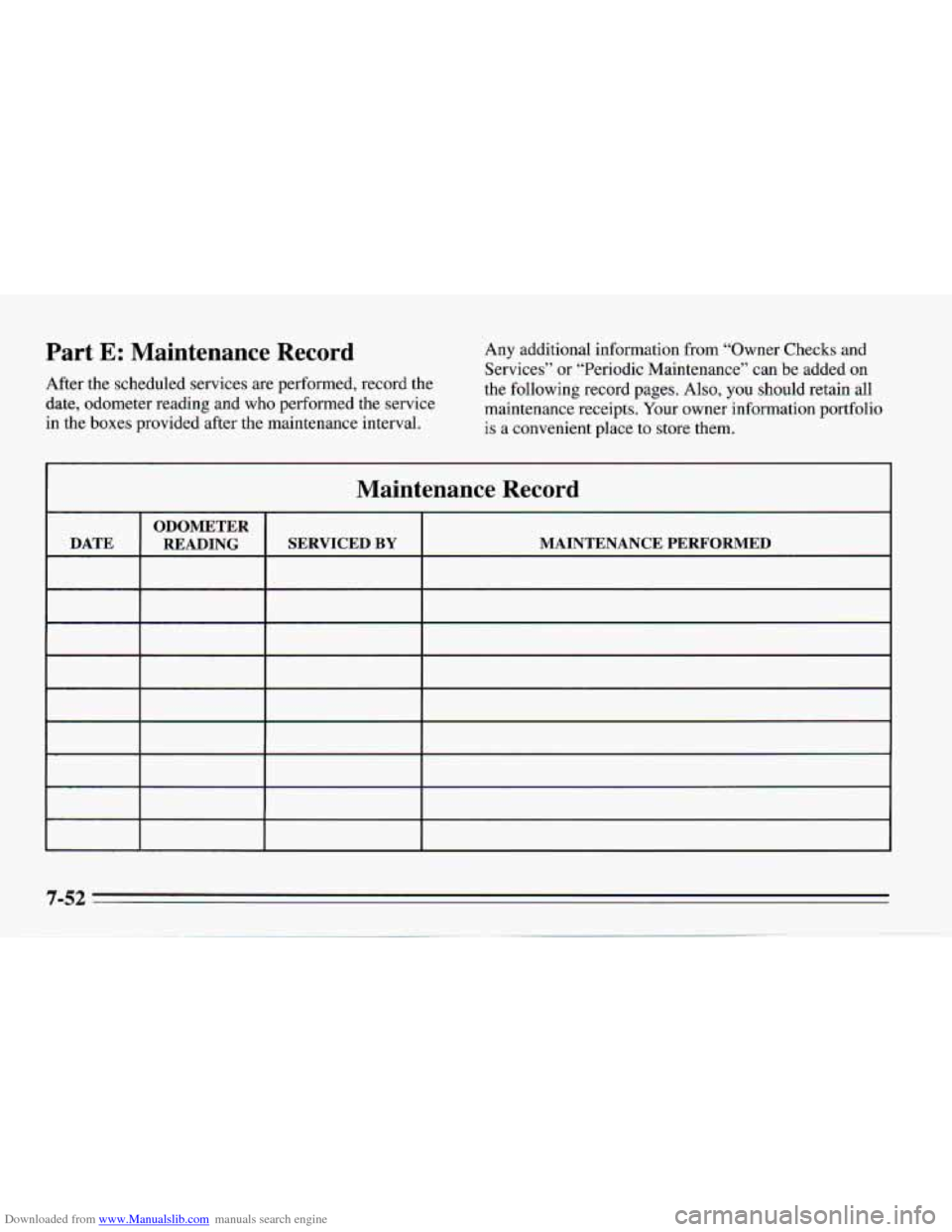
Downloaded from www.Manualslib.com manuals search engine Part E: Maintenance Record
After the scheduled services are performed, record the
date, odometer reading and who performed the service
in the boxes provided after the maintenance interval.
Any additional information from “Owner Checks and
Services” or “Periodic Maintenance” can be added
on
the following record pages. Also, you should retain all
maintenance receipts. Your owner information portfolio
is a convenient place to store them.